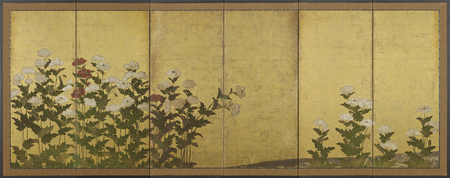Product Description
7371 A six-fold paper screen painted in ink and colour on a gold ground with hinageshi and shirogeshi (red and white poppies)
Japan 17th century Edo period
Dimensions: H. 113cm x W. 280cm (44½” x 110¼”)
Keshi has two meanings, poppy and erase, as this poem by Hokushi (d. 1718) so eloquently illustrates.
Kaite mitari I write, erase, rewrite,
Keshitari hate wa erase again, and then
Keshi no hana a poppy blooms.
For the screens depicting red and white poppies by the Rimpa School artists, see Kobayashi Tadashi ed., Rimpa Painting Volume II: Seasonal Flowering Plants and Birds, (Japan, 1990), p. 82-83, pl. 140-141.
For a pair of six fold screens, one depicting mugi (wheat) and the other poppies in the collection of the Idemitsu Museum of Art see: Nihon Byuōbu e Shūsei, Vol.7, Flowers & Birds, Four Seasons’ Plants & Flowers,1980, p.37-36 pl.18






